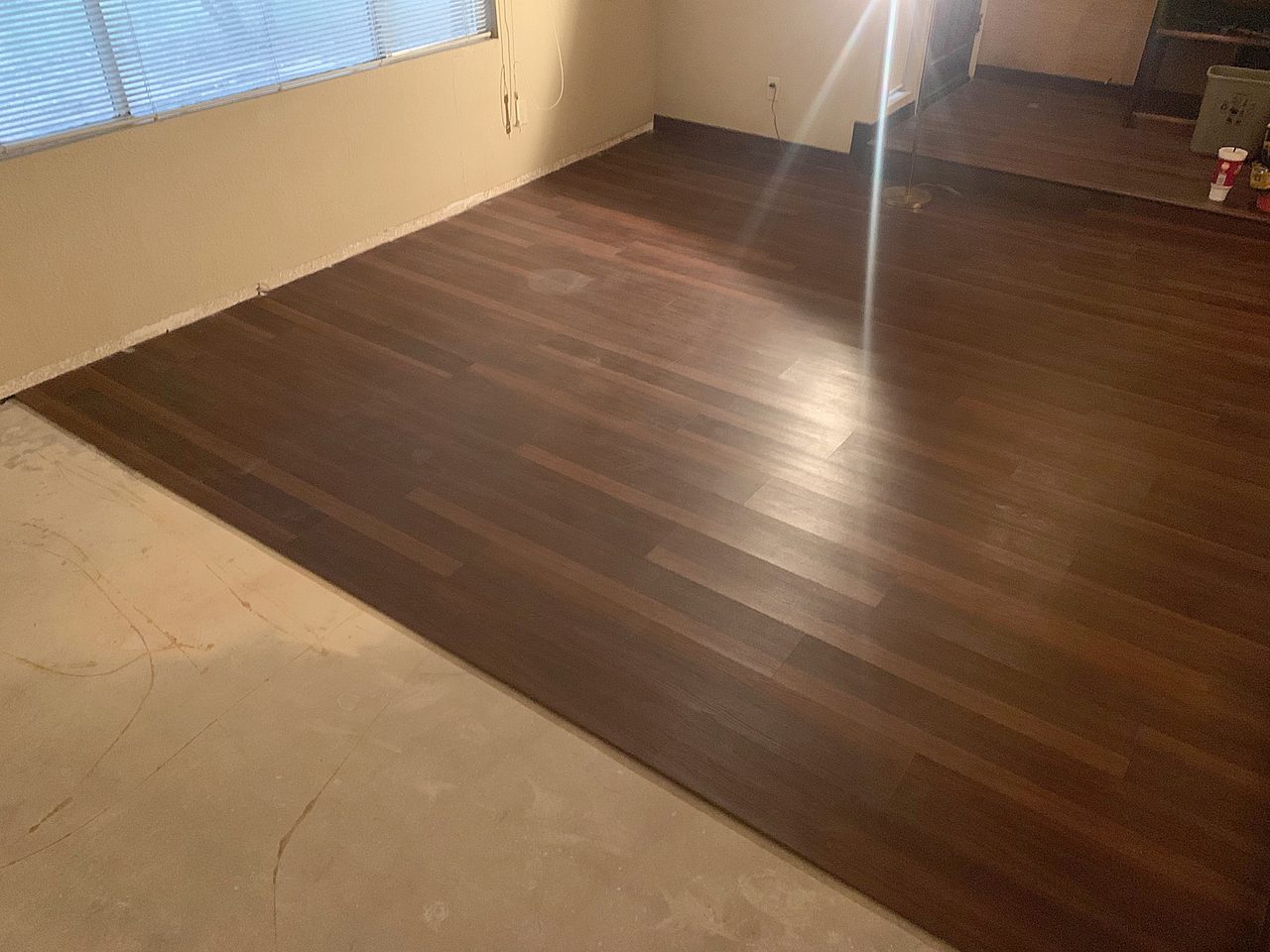INSTALLATION
By Kyle Hedin
Floor Academy Briefing:
Increasing Profits with Instructions
The entire flooring installation had cupped and had to be removed. Photo: Kyle Hedin.
I recently came into a project where the homeowner had to have the flooring pulled up so the termite guy could inject spray inside the home at an interior wall on the opposite side from the action. I spoke with the homeowner about the different options that were available and why the termite guy was going to such great lengths. I actually respected it because he was making sure he treated the situation as thoroughly as possible. I submitted my number to take up the flooring and to install it again after the treatment and had it accepted.
The day came to do the removal and everyone was in for a surprise. The first thing I noticed upon pulling up a few planks was that there was no vapor barrier installed over the concrete on grade. The next issue was that all the planks were cupped. Lastly, I flipped over a plank and realized there were little dots and spots all over it. The room had horrible lighting and it was early in the morning, but with a little help from the light on my phone, I could clearly tell the cork backing had mold growing on it. I checked the rest of the flooring and had a discussion with the client about their install.
Hedin discovered that the homeowner's previous floor installation had not included a vapor barrier over the concrete on grade. Photo: Kyle Hedin.

At the time of the install, the client and her husband went out of town to allow for an easier go of it. They returned before the job was completed and noticed there was no underlayment being installed and questioned the installation company about it. The installation company responded that it wasn’t needed, and there would be no issues. We can all see there are issues now, and their concerns were spot on. In Arizona, where I live, the state requires a two-year workmanship warranty on any installation when you are licensed through the state. Anyone doing work over $1,000, including materials, is supposed to be licensed. The worst thing in this instance is that the install was somewhere around two years and two months. I’m not sure if gross negligence can be proven or not, so we will avoid going down that road and focus our attention elsewhere.
There is a lot of money to be made in this industry by doing things according to the instructions that come in a box or on the back of a bottle or can. They are there to make our lives easier, allow you to see how the product is meant to be used, and written by the people who made it. In most cases, scientists developed a lot of these products and know how they should react to different environments and mixing conditions. When a self-leveling underlayment says it has certain water requirements, follow them because that is how the product was designed to be used. When you go outside of the recommended use, you are compromising the product. Testing after the fact can determine if it was done properly or not. The big companies have better lawyers and bigger pockets than us, but if we make sure to check all of our boxes, dot our I’s and cross our T’s, then warranties should stand. I don’t want my bank account or insurance policy backing a project when I can have the manufacturer do it.
So, how do you make money following instructions? How many companies do you know in your area completing proper moisture testing according to ASTM 1869 and ASTM 2170? My guess would be probably not many. These tests cost money and time. They will also set you apart from your competition and allow your professionalism to shine through because you are the only one doing them. The product instructions say that they need to be done. Why are none of the other contractors performing them? Your expertise here can quickly move you to the top of a list and allow the value of what you are providing to easily justify your higher expense. You most likely won’t be looked at as more expensive because your services are on an entirely different level.
Upon closer inspection, mold was found on the cork backing. Photo: Kyle Hedin.

Relative humidity (RH) tests can be done for roughly $50 per probe—your cost—after investing in the system. At that price, I sell each probe for $100 to the client. Then, I look at how much drive time to go back and forth and bill that at $100/hour. Most tests will be a $500 minimum. You need three probes for the first 1,000 square feet and one for each additional 1,000 square feet. So, figure drive time as an hour there and back, performing the tests and a return trip at another hour there and back, you land at a minimum of $500. If you want to add a little extra time for test setup, you can, but the drive time typically isn’t a total of an hour each way and the tests don’t take long to setup. The same rules apply for doing calcium chloride tests, but the tests are a little cheaper at around $40 for a three-pack. The testing time for calcium chloride is longer though. The biggest thing to remember about these tests is that they are a snapshot in time. They let you know that right now it is okay or not okay to install the flooring. Assuming it is okay, your butt is covered and you have the proof you need to proceed with the install.
Conditions and environments change though. Perhaps the backyard gets redone at some point, and the grading is changed improperly. This causes water to collect against the side of the house and absorb into the slab. This will easily change the moisture in the concrete and could create issues.
The next thing you can do with an install over concrete is to offer a very cheap form of insurance in 6-mil plastic. Sure, your tests said it is okay now, but as I stated, it may not be later. You can pick up 1,000 square feet of plastic for roughly $70. That roll of plastic could be sold for $0.25 per square foot or $250 total. Assuming the project was 1,000 square feet, an insurance plan of $250 dollars is probably the cheapest insurance policy your clients can ever buy. It will also give you more protection down the road in case the environment changes.
Most manufacturers will have instructions that stipulate a 6-mil plastic vapor barrier is recommended on concrete installations. As I mentioned earlier, the manufacturers have a bigger bank account and better lawyers than I can afford. “Recommended” to me means you better put that plastic down or you are asking for trouble. By putting the plastic down, you are able to make an easy upsell on a very profitable item.
Reading through the instructions, you can find ways to not only properly do your projects but also find ways to make upsells or move more product that puts extra profit in your pocket. I want to minimize my liability on any installation as best I can so it is not my bank account backing projects. However, if my bank account does end up having to back a project, I enjoy knowing I have charged enough to be able to pay my way out of a project without an insurance claim. From moisture tests, to vapor barriers, to proper adhesive coverage, and proper floor prep for flatness tolerances, I wish you all happy reading and a more profitable year through client education and proper installation procedures.

CONTENTS
With a degree in digital filmmaking and video production, Kyle Hedin is not a likely fit in the flooring industry. However, after evaluating his skillset in June of 2015, he decided flooring was a great option. With a passion for wood working as a teen, Kyle cold called 30 contractors in his area asking for a job as an apprentice. Two companies got back to him, and after a stint at both, he was out on his own by September 2017. While still very new and needing to learn, Hedin discovered an online community of installers on Facebook that helped him grow his hand skills. What he did notice was that not many of them understood the business side of things. In 2019 the Floor Academy Podcast was born to help craftsmen stop playing contractor and to become businessmen. Each episode is an interview with an expert in the flooring industry or their related field to provide insights into how to grow your business, save you time and put more money in your pocket.
